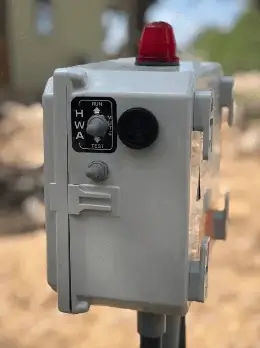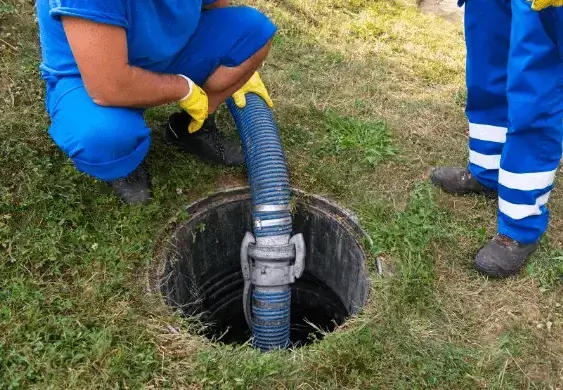Introduction
If you have a septic system at home, you know that it is crucial to keep it running smoothly to avoid costly repairs and potential health hazards. One of the indicators of an issue is the septic light turning on, but no alarm sounding. In this article, we’ll discuss the causes of this problem and offer solutions to help you keep your septic system functioning properly.
What Does The Septic Light Mean?
Before diving into the causes and solutions, let’s first understand what the septic light indicates. The septic light, also known as the “pump” or “alarm” light, is an indicator that your septic system is not working correctly. Typically, the light is connected to a float switch that triggers the septic alarm when the water level in the tank gets too high.
Septic Red Light On But No Alarm: Causes

Septic alarms are essential devices that monitor the wastewater levels in the septic tank. When the alarm goes off or a red light switches on, it typically indicates a high wastewater level or high levels of sludge in the tank. Understanding the causes behind these alarming situations is crucial for proper maintenance and prevention of septic system failures. If your septic light is on but no alarm is sounding, there are several potential causes:
1. Excessive Household Water Usage
One of the main reasons for a high water level in the septic tank is excessive water usage within the household. Activities like extended showers, constant toilet flushing, or running multiple appliances simultaneously can overload the septic system, leading to a rise in wastewater levels.
2. Heavy Rainfall Saturating the Drain Field
During periods of heavy rainfall, the drain field can become saturated, causing the wastewater to rise in the septic tank. When the ground is already soaked, the excess water has nowhere to go, putting additional strain on the septic system.
3. Electrical Fault
Electrical problems can also be the cause of the septic light turning on without the alarm sounding. The electrical wiring may be damaged, or there may be a blown fuse or tripped circuit breaker.
4. Clogged Effluent Filter
An effluent filter is installed in the septic tank to prevent solids from entering the drain field. However, if the filter becomes clogged with debris or sludge, it hinders the flow of wastewater, causing the water level to rise.
5. Malfunctioning Septic Pump
A malfunctioning septic pump can disrupt the proper flow of wastewater from the septic tank to the drain field. If the pump fails to operate efficiently, the water level in the tank will rise due to inadequate drainage.
6. Clogged Drain Field
Over time, the drain field pipes may become clogged with accumulated solids, preventing the proper absorption of wastewater. When the drain field fails to disperse the water effectively, it can result in a rise in the water level within the septic tank.
7. High Levels of Sludge
Over time, solid waste in the septic tank accumulates as sludge at the bottom. If the sludge levels become too high, it can reduce the tank’s capacity to hold wastewater, resulting in an elevated water level.
8. Float Switch Failure
The float switch is a critical component that triggers the alarm when the water level in the tank gets too high. If the float switch fails, the alarm won’t sound even if the water level is high.
9. Faulty Alarm
A faulty alarm may be another reason why the septic light is on but no alarm is sounding. If the alarm is malfunctioning, it won’t trigger even if the float switch is working correctly.
10. Clogged Pump
A clogged septic pump can also cause the septic light to turn on. If the pump is clogged, it may not be able to keep up with the flow of water, causing the water level in the tank to rise and triggering the light.
11. Faulty Aeration Device or Septic Air Pump
In septic systems that utilize an aeration device or septic air pump, a fault in these components can lead to a rise in water level. Proper aeration is essential for the breakdown of organic matter in the septic tank. If the aeration device or air pump malfunctions, it can disrupt the wastewater treatment process and result in increased water levels.
12. Mechanical Problems in Components
Mechanical issues with the air compressor, float switch, or other septic system components can also cause the water level to rise in the tank. These components are essential for the proper functioning of the system. Any malfunction or failure can disrupt the balance and contribute to elevated water levels.
Septic Light On But No Alarm: Solutions
If you notice that your septic light is on but no alarm is sounding, here are some solutions you can try:
- Hit the Red Button: Locate the red button on the septic alarm box and press it to turn off the septic alarm. This action will initiate a 12-24 hour period during which the system should run normally. It is important to note that during this period, you should reduce your household water usage to help lower the water level in the septic tank.
- Monitor the Red Light: During the 12-24 hour period, the red light on the septic system should switch off automatically. If the red light remains on after this period, it indicates potential issues that require further attention.

Red Light On The Septic System Is Still On!
If the red light remains on after reducing household water usage for 24 hours, you should try the following steps to address the issue:
1. Check Float Switch
Start by checking the float switch to ensure that it is functioning correctly. If it is stuck or not working, you may need to replace it.
2. Test Alarm
Next, test the alarm to see if it is working correctly. If the alarm is not sounding, you may need to replace it.
3. Check Electrical Wiring
Inspect the electrical wiring to ensure that there are no issues. Replace any damaged wires or blown fuses and reset any tripped circuit breakers.
4. Clean Pump
If the pump is clogged, you will need to clean it to restore proper function. You can use a garden hose or hire a professional to clean the pump.

5. Pump Or Clean Out The Septic Tank
The persistent red light may indicate high levels of sludge in the septic tank. In this case, it is necessary to pump or clean out the tank to remove the accumulated sludge. Contact a professional septic service provider to perform this task properly.
6. Check The Septic Tank Pump
A malfunctioning septic pump can also cause the red light to stay on. Inspect the pump to ensure it is operating correctly. If you notice any issues or abnormalities, it is advisable to call a septic technician for repair or replacement.
7. Inspect the Drain Field
A problematic drain field can contribute to the red light staying on. Check the drain field for any signs of saturation, clogging, or damage. Standing water, foul odors, or unusually lush vegetation in the drain field area may indicate a problem. Seek professional assistance to assess and address any drain field issues.
8. Clean the Effluent Filter
The effluent filter in the septic system prevents solids from entering the drain field. Over time, the filter can become clogged, leading to poor drainage and increased water levels in the tank. Clean the effluent filter to ensure proper flow. If the filter is damaged or severely clogged, it may need replacement.
It is important to note that these steps are general guidelines, and specific situations may require professional assistance. If the red light persists after attempting these measures, it is recommended to contact a septic technician who can diagnose and resolve the problem effectively.
Septic Light On But No Alarm: FAQs
Here is a list of the most common FAQs about “Septic Light On But No Alarm“
Septic Light On But No Alarm: Conclusion
A septic light turning on without an alarm can be a sign of a problem in your septic system. The causes could be due to float switch failure, faulty alarm, electrical issues, or a clogged pump. The solutions to these issues include checking the float switch, testing the alarm, inspecting the electrical wiring, and cleaning the pump. Proper maintenance and timely repairs can help keep your septic system running smoothly and avoid costly repairs.

